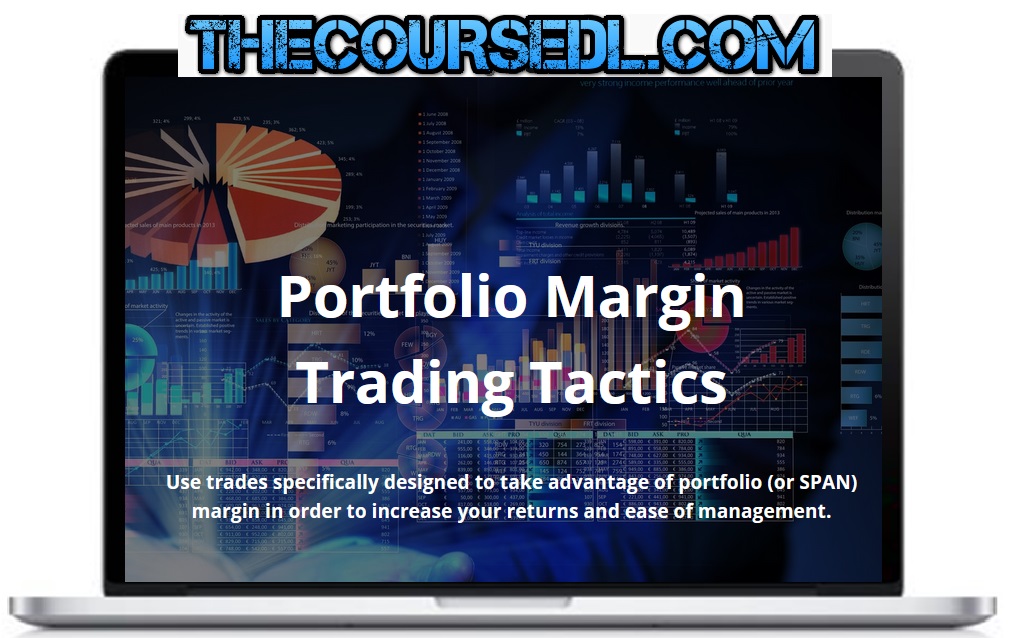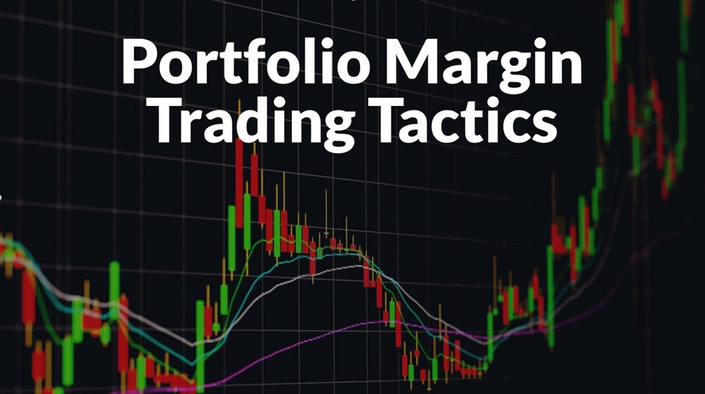Description
 Ron Bertino – Portfolio Margin Trading Tactics
Ron Bertino – Portfolio Margin Trading Tactics
Original Price: $1475
You Just Pay: 149.95$(One Time 90% OFF)
Author: Ron Bertino
Sale Page:_https://university.tradingdominion.com/p/portfolio-margin-trading-tactics
Product Delivery : You will receive a receipt with download link through email.
Contact me for the proof and payment detail: email_Ebusinesstores@gmail.com Or Skype_Macbus87
Why use portfolio or SPAN margin?
Most people think that portfolio margin (PM) or SPAN margin is just used by traders who want to get significant leverage, and therefore need to be comfortable taking larger risks.
There certainly is leverage with portfolio or SPAN margin, but what most people don’t realize is that, if used properly, you can use PM or SPAN margin in order to construct risk profiles which are much safer than what you could construct with RegT margin. There are even certain trade types which are completely not viable at all with RegT margin, and can only be done with PM or SPAN margin.
This course will teach you how PM and SPAN works, how to construct, and how to manage trades which are specific to PM and SPAN.
We primarily focus on creating trades which have much more safety than RegT trades, such that even in the event of a black swan your overall portfolio is protected.
Can you afford to lose your entire trading account?
Instructors who teach conventional trading strategies with RegT accounts will typically state that your trading account should consist of a maximum of 20% of your liquid net worth. This implies that if you want to have a trading account of $100K, then you’ll need a liquid net worth of $100K / 20% = $500K
On top of that, they will typically recommend that you keep 50% of your trading account in cash. So out of your $100K trading account, you can only trade $50K.
The reason for these two recommendations is because they don’t teach you how to protect your trading portfolio from black swan events.
The typical advice is that a black swan may come every 5 to 10 years or so, and when it comes you have to be willing to have your entire account get wiped out. Since you only had 20% of your liquid net worth invested in your account, and you were keeping 50% of that trading account in cash, then you should have sufficient extra funds in order to start over again.
We don’t find the above situation acceptable.
We teach you how to structure your trading account such that your overall portfolio can withstand a black swan event. This therefore allows you to actively trade a larger portion of your net worth, and tends to allow you to sleep much better at night.
How much can you expect to make?
Let’s just pick a generic number. If you can consistently make a 20% return on your entire account every year, then you would be performing at levels comparable to the best hedge funds in the world.
So let’s apply this yearly return to the criteria we had listed above. We had mentioned that most people will teach to only trade 20% of your liquid net worth, and then keep 50% of your trading account in cash.
If you had a liquid net worth of $500K, then you could have a trading account of $100K and you would actively be trading $50K of that account.
If you were to then make a 20% yearly return on your traded capital of $50K, that comes to $50K * 20% = $10K profit per year.
Even if you were to trade your entire $100K, and not implement the suggestion of keeping 50% in cash, then you would be making $20K per year, on the assumption that you had a total liquid net worth of $500K.
Do you want to trade for a living?
Let’s use the info from above, which is what is recommended by mentors teaching RegT style options strategies.
If you wanted to trade for a living, and your expectation was to be able to make $10K profit per month, that implies needing to make $120K profit per year. If that’s going to represent a 20% yearly return, that implies that you need a total trading account in the size of $120K / 20% = $600K. If you were to keep 50% in cash, that implies needing an account of $1.2 million, and if your account is 20% of your liquid net worth then you need to have a total liquid net worth of $1.2 M / 20% = $6 million.
So while the concept of only trading 20% of your liquid net worth and keeping 50% of that in cash sounds completely reasonable, you need to marry that with the reality listed above in terms of how much money you can expect to make overall. If you want to trade for a living and make $10K per month, then you’ll need to have a liquid net worth of $6 million…….if you trade using traditional methods.
If you don’t have a spare $6 million lying around, then you’ll need to learn how to be able to trade a much larger portion of your net worth, and also how to trade a much larger portion of your trading account, while doing so with as much safety as possible.
You can only do that if you have a portfolio of trades that can withstand black swan events, yet still provide you with a very good return.
That’s exactly what you’ll learn to do in this course.
Isn’t black swan protection expensive?
Think of black swan protection as insurance for your trading account.
Do you spend money on car, home, health or life insurance? Of course you do, and you likely couldn’t even imagine being without it.
So if insurance is so important, then why wouldn’t you insure your trading account, which may contain a large portion of your net worth?
Most traders would answer “because it’s too expensive and black swan events are very rare”.
How often do you plan on getting cancer? How often do you plan on kicking the bucket? Just because we only plan to die once isn’t a reason to not have life insurance. Just because we don’t plan on getting cancer every year is not a reason to not have health insurance. So just because an event is rare, this is no reason to not have insurance to cover that risk.
I’m willing to bet that you’ll see many more black swan events than the number of times you’ll get cancer or die.
Another very important point is that out-of-the-money structures are much easier to protect against black swans than at-the-money structures. In this case, “easier” implies much cheaper, and getting a good return on margin for out-of-the-money structures can only be done with portfolio or SPAN margin.
Black swan protection does cost money though, so in the course we tend to address this in three ways:
We design income trades which are very resilient against a strong down move, yet can still produce a very attractive return on margin. Being able to leverage PM and SPAN margin is almost essential to doing this effectively.
We have some strategies which are primarily focused around portfolio level protection, rather than income generation.
We also have a number of creative financing strategies for the costs incurred for the black swan protection.
Learn to manage an entire portfolio rather than a single trade
Most traders are on a constant and never ending hunt for the holy grail. They want to find the perfect trade which can make a fantastic return in every market condition as well as withstand a black swan event without taking a loss.
Allow me to save you time and money, and tell you that there’s a reason it’s called the “holy grail”, and that reason is that it doesn’t exist.
You need to start by creating two broad categories of trades: income trades versus hedges. Hedges are there to protect your portfolio, and you should therefore not expect to make money from them most of the time. The ideal situation with a hedge is that you can get creative with finance strategies such that you can end up with “free hedges”, while not compromising the power of the hedge too much.
When it comes to incomes trades, you also need to realize that there are many different market conditions, which are hard to predict in advance. You have strong down, grind down, sideways, grind up and strong up markets…..not to mention that vertical skew and term structure can also potentially affect the performance of your income trades.
Rather than trying to find one trade which “does it all”, you’ll typically get a much smoother equity growth curve if you’re actively trading a few different trades at the same time. You may have one hedge which is great for protecting against black swan events, and another hedge which is great for a grind down market. You may have one income trade which is great for a grind up or bullish market, and then another income trade which is great for sideway choppy markets.
You also need to keep your entire portfolio risk under control by analyzing the 1st and 2nd order greeks of your entire portfolio, rather than having a myopic view of just a single trade.
Last but not least, you can use a profit hump from one trade as a hedge for another trade. For example, you may have one trade which has developed a beautiful profit hump which has built up just under the current market levels. Once you know that, then this allows you to potentially take more bullish directional risk with a new income trade, since you know that even if you are completely wrong, you have that nice profit hump waiting just below you from the other trade.
You therefore want to learn to manage an entire portfolio of trades rather than a single trade for the following reasons:
have a blend of income trades as well as hedges to protect your portfolio
have a smoother equity curve, by implementing a few different trade types for both hedges as well as income trades (where each trade type may be better suited for a different market condition)
portfolio level risk control by analyzing the 1st and 2nd order greeks of your entire portfolio
being able to leverage one trade against one another in order to reduce risk and increase profits
What does a standard trade look like?
The following risk graph is from one of our “mechanical combos”, which combines an income STT trade together with a financed downside hedge.
You can see that we have a super flat T+0 line from around -8% down through to as high as the market wants to go.
Also notice the nice theta distribution and spacing, as represented by the various T+X lines.
On top of that, backtesting has shown that this trade can withstand a black swan event such as the Aug 2015 crash.
Automated backtest of the mechanical combo #1
Although many of our members prefer to trade using their own discretion, we have also created some trades which can be traded mechanically.
Here are the results of our “mechanical combo #1”:
Setup
Automated backtest of 1671 trades from 2014 to today
New trade initiated every 15 mins
Profit target: $600
Max loss: -$1500
Slap on/off trade; no adjustments
Initial PM: $2100
Results
% winners: 89.47%
% losers: 10.53%
Avg DIT: 35.2
Avg winner: $600
Avg loser: -$1100
Avg P&L: $420
Does it scale?
We have multiple people in our community who trade in large size.
There are various members in our community who run hedge funds; some with millions of dollars under management.
We also have many private individuals who simply trade their own money, but do so in large size. For example, one of our members tends to trade 600 tranches of our trades at a time.
You can therefore start with just a single tranche, which may have a portfolio margin as low as $5K and planned capital of $10K, but also have the confidence of knowing that as your account gets larger and larger, that you’ll still be able to do the same trades in much larger size.

Course Curriculum
Introduction
Welcome (1:20)
Getting to know you
Quick personal introduction (8:19)
Course overview (20:05)
University tour
OptionNet Explorer discount
Analysis spreadsheets (16:44)
Trading for a living (17:10)
Portfolio margin (28:12)
Foundations
Introduction (4:56)
Quick visual intro to the first order greeks (9:31)
Second order greeks (55:09)
Reading the inflection points on an expiration line (5:57)
Greeks of a put debit spread (9:02)
Delta Power (6:31)
Buying cheaper greeks (13:31)
Comparing relative spread prices (8:10)
OTM options decay faster than ATM options (17:54)
ATM structure pricing and IV (8:16)
Relationship between volatility and time (8:08)
How the T+0 is affected by a change in IV (4:12)
Options in further out in time expirations are easier to manage (9:07)
IV versus HV (18:54)
Vertical Skew – part 1 (40:52)
Vertical Skew – part 2 (50:51)
Trading further out in time (13:26)
Measuring skew steepness (18:13)
Term Structure and weighted vega (96:33)
Put / Call parity (24:01)
IB TWS Tool for skew analysis (3:02)
Backtesting (21:50)
Market circuit breakers (13:12)
Walking the option chain (15:52)
Foundations summary (4:25)
Space Trip Trade
STT introduction (8:17)
Standard Space Trip Trade (15:18)
Standard STT – sample setup (31:03)
Standard STT – let’s do it live (22:00)
Optimizing entry (25:06)
Legging in (6:40)
Middle STT (11:30)
Front STT (6:05)
Front STT – comparisons (15:25)
Road Trip and Space Trip (3:43)
Bearish STT (29:47)
Bullish STT (15:34)
Bullish STT – sample setup prior to the Brexit event (17:45)
Trade management – intro and quick review (8:01)
Downside management (10:30)
Downside adjustments – rolling down (0:53)
Downside adjustments – long put (2:32)
Downside adjustments – put debit spread (38:51)
Downside adjustments – adding another STT (1:43)
Downside adjustments – adding a bearish STT (0:35)
Downside adjustments – 1 SD OTM balanced butterfly (3:33)
Downside adjustments – hitting pause (28:33)
Downside adjustments – hitting pause – comparing expirations (8:02)
Downside adjustments – price reversion (10:32)
Downside adjustments – hedging off bearish adjustments (10:03)
Downside adjustments – using stocks or futures (7:58)
Downside adjustments – TOS contingent orders (4:20)
Upside management (0:51)
Harvesting (13:55)
Upside adjustments (7:42)
Price layering (17:35)
Playing whack-a-mole (4:12)
Taking profits (8:32)
Quick Hit STT (15:32) (15:32)
Opportunistic management (3:15)
STTs on the call side (6:59)
Using futures options with a RegT account (3:50)
STT – summary (2:29)
Black Swan Hedge
Black swan examples (20:41)
BSH core concepts (33:21)
BSH vs teenies (9:35)
First BSH configuration (64:11)
Second BSH configuration (11:02)
Third BSH configuration (7:20)
Fourth BSH configuration (30:02)
Optimizing the BSH (32:26)
Upside adjustments
Long call (6:36)
Peel off existing upside call credit spreads (2:56)
Put credit spreads (10:16)
Call debit spreads (2:39)
Bullish risk reversal (2:49)
The kite (2:33)
Call back ratio (1:30)
Upside calendar (4:07)
Upside ratio calendar (2:21)
Short diagonal (6:02)
ThinkOrSwim (TOS) tips
Managing your trades (17:54)
Price triggered contingent orders (7:22)
Study triggered contingent orders (9:29)
Importing a TOS grid
Seasonality indicator
Standard deviations indicator
IV and HV indicator
Volatility term structure indicator
Triple Keltner and ATR Trend indicator combo
My main TOS grid
Butterfly pricer indicator
Managing the entire portfolio
Back STT + BSH (39:59)
Entering during different IV levels (12:25)
Bullish STT + BSH (8:52)
Protected jeep (17:36)
Portfolio sizing (52:54)
Simple Trend Following System (STFS) – v2 (16:31)
STTBWB and BSH during the Feb 2020 crash (53:26)
Double wide STT and BSH (71:46)
Core trades and tactics
Mechanical trend following indicator (DSTFSv2) (15:53)
Simple Trend Follows System (STFS) – v3 (57:43)
STT-BWB (76:46)
Dynamic sizing for the STTBWB and BSH (108:30)
2021-03-24 – Group coaching (188:16)
Walk through of the STTBWB+BSH during the 2020 Covid crash (47:08)
Walk through of the STTBWB+2LP during the Jan 2022 pullback (46:54)
Hedging with futures (25:39)
Summary
Final summary (39:16)
That’s all folks (6:21)
Refer a friend program
Bonus content
Main bonuses
IRA Custodian
Broker – APEX
Broker – TradeStation
Broker – ED&F Man
Bonus – online meetings
Meeting on Jan 19, 2017 (78:12)
Meeting on Jan 26, 2017 (83:54)
Meeting on Feb 2, 2017 (78:27)
Meeting on Feb 9, 2017 (82:34)
Meeting on Feb 16, 2017 (85:02)
Meeting on Feb 23, 2017 (89:15)
Meeting on Mar 2, 2017 (92:59)
Meeting on Mar 9, 2017 (91:08)
PMTT Mastermind Group
Mastermind group (9:22)
Advanced options analysis spreadsheets
Spread and option chain analysis
You’ll get access to advanced spreadsheets which allow you to get detailed information on various spreads (naked options, verticals, broken wing butterflies, black swan hedges, etc). These spreadsheets can be leveraged in order to try to find extra edge in a position prior to entry (eg seeing that the spread right next to the one you plan to purchase might be available a bit “cheap”), or to help you track your existing positions such that you can see both 1st order and 2nd order greeks.
While doing an option chain deep dive can be potentially useful, note that there is absolutely no need to use these spreadsheets for either setup or management of your trades. We have all of our trade plans fully documented, and entry and management is based on traditional things such as greeks, the dollar value of certain strikes, or expected moves. You can therefore fully trade all of our setups without ever opening any of these spreadsheets.
Special Bonuses
Bonus 1: Simple Trend Following System
Many delta neutral income traders tend to hate technical analysis. Yet, these same traders will complain that one of their income trades took a hit because of a grind down market which came out of nowhere, or a huge bull run which they wish they could have foreseen.
The Simple Trend Following System (STFS) is an extremely easy to understand technical analysis system which uses only two simple indicators and price action in order to keep you on the right side of the market. There is zero discretion involved, and is 100% mechanical in the definitions of the rules for entry and exit.
You’ll be able to learn this system in under 30 minutes and be able to use any trading platform to implement it.
The main intent is to use this system in order to keep your income trades on the right side of the market, help you time entry into new trades, and minimize the drawdowns you’ll see.
Bonus 2: Exclusive discounts with futures brokers
If you are looking to leverage SPAN margin and therefore trade futures options, you will pay the following retail rates:
TD Ameritrade: $2.25/contract + exchange fees
Interactive Brokers: $0.85/contract + exchange fees
We have organized exclusive deals with some other futures brokers where you will be able to pay a blended fee (broker plus execution platform) of $0.65/contract + exchange fees.
Just by being a member of our Trading Dominion community, you’ll be able to leverage these very competitive rates.
Bonus 3: Trade futures options in your IRA without any penalties
Some brokers, such as TD Ameritrade, will allow an IRA to to trade futures, but not futures options.
Other brokers, such as Interactive Brokers, will allow an IRA to trade both futures and futures options, but will apply a variety of penalties to these accounts, such as charging 3 times the normal amount of SPAN margin, or adding penalties for using long dated expirations.
We have exclusive arrangements with certain brokers, where you will not only get the very competitive commission of $0.65/contract, but you will also have no penalties applied to the IRA account. Your IRA will be treated exactly the same as any other account type.
Bonus 4: Trade your IRA in a portfolio margin account
We have already mentioned that you’ll learn how to setup your IRA account with one of the brokers we have exclusive agreements with in order to be able to trade futures options, leverage SPAN margin, and not have any penalties applied.
If you are willing to spend a bit more money up front in order to set up a different type of business entity for your IRA, you will also learn a way to be able to setup a portfolio margin account for your IRA with almost any broker of your choosing, including TD Ameritrade (TDA).
Being able to trade portfolio margin with your IRA would allow you to trade SPX with TDA, and therefore save a significant amount of money in commission costs.







Reviews
There are no reviews yet.